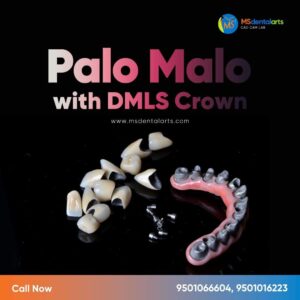By Sarfraz Ahmed

The methods used in clinical and laboratory settings for crown fitting are widely known. It is necessary to transmit clinical data from the oral cavity to the laboratory and back again. Clinical and/or laboratory processes could have led to crowns that don’t fit properly. Both sides of the spectrum require a high level of quality control. Crown seating procedures must to be dependable and consistent.
The difficulty with loose-fitting crowns is typically locating the precise point of contact so that an adjustment can be made. Adjusting the crown by guesswork or eyeballing takes time and does not always result in a perfect fit. Unacceptable crowns that don’t fit properly shouldn’t be cemented.
In three sections, this article outlines the clinical and laboratory perspectives on crown procedures:
Part I: Seating Crowns as Recieved from MS Dental Arts Lab
Part II: Potential Roots of Poor Crown Fit
Part III: Clinical Treatments for Dislodged Crowns
Part I: Seating crowns as they were delivered by MS Dental Arts Lab
Lab procedures:
- Check the crown both on the die by itself and on the mould. Magnification is advantageous. The die’s margins and the crown margin should line up perfectly.
- Put the crown on the die and the die into the cast. It ought to be simple to slide into position. The interproximal connections are AREAS, not points, keep that in mind. The middle third of the axial walls and the middle to buccal thirds buccal/lingually should be the areas of contact. Contact Areas for Dental Crown Margins
- Close the upper and lower articulator components to assess the occlusion. Articulating paper should fit snugly between each tooth.
Clinical actions
- Clean the prep of cement and dirt after removing the temporary crown. Try it in the crown; if it doesn’t sit all the way down, test the interproximal contacts with floss. Adjust as necessary until the crown is properly seated. In order to verify seating, take a bitewing radiograph.
- Examine the occlusion; the crown’s occlusal surface should not be “high.”
- Permanent cement is polished into the crown.
- Remove any extra cement:
- If unsure of whether all cement has been removed, another radiograph may be required.
- Check the occlusion once more.
- Present the patient with the crown.
Part II: Potential reasons why crowns don’t fit properly
Micro-leakage: When the luting cement used to secure the crown to the tooth structure dissolves, micro-leakage results. As a result, there is a small flaw between the preparation and the crown.
Cementation: Crowns that have not been properly cemented run the risk of coming loose if the manufacturer’s recommendations are not followed or the cement is improperly mixed.
Tooth Decay: If not kept clean, restored teeth are more prone to plaque buildup and caries. This may eventually result in tooth decay underneath the crown.
Bruxism: By dislodging or fracturing the cement, bruxism, or grinding your teeth, can loosen crowns.
Diet: Taffy and other sticky foods, such candies, can entirely dislodge crowns.
Note: Every effort is made to verify that all crowns fulfil laboratory requirements using MS Dental Arts Lab quality control methods. Before packaging, all crowns will fit the dies and/or casts appropriately. Crowns that don’t fulfil these requirements won’t be given back to doctors.
Part III: Medical solutions for loosened crowns
- Analyze the preparation and the crown. With the aid of hand tools, steam cleaning, or air particle abrasion, remove any dirt that is inside the crown.
- Reposition the crown onto the preparation and assess the integrity of the margin. To assess subgingival regions, do a bitewing radiograph. If everything is in order, just re-ceil the crown. It is recommended to get the dental crown made again if it is loose because of tooth decay apical to the borders.
Zirconia crowns being re-cemented
- Change your cementation procedure if your zirconia crowns are debonding or coming loose. Before polishing the tooth with pumice, the majority of dentists test the zirconia crown’s comfort in the patient’s mouth.
- If the cement does not include a built-in primer, proceed by decontaminating the intaglio surface of the zirconia restoration before preparing it with a priming agent or adhesive. Since light does not reliably penetrate zirconia, the cement should be dual-cured (light and chemical).
- The crown should next be cemented and light-cured from various angles in accordance with the manufacturer’s recommendations. As above, scrape away any extra cement.
Patients who have poorly fitting crowns may become dissatisfied. Call our lab directly to speak with a member of our knowledgeable technical team about your unique situation if you have fit problems with MS Dental Arts Lab crowns. The technical team at MS Dental Arts Lab is prepared to assist in finding the best solution for problems involving ill-fitting restorations and will collaborate with your office to do so.


No comment yet, add your voice below!